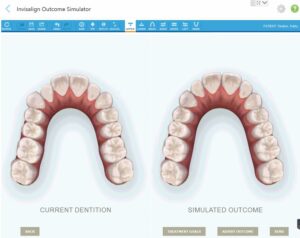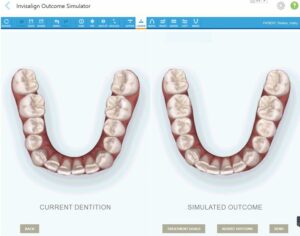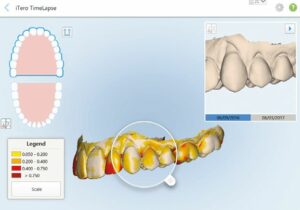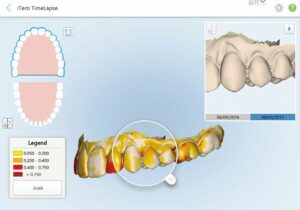The unexpected evolution of oral health.
Throughout a dental career, it is inevitable to experience moments we wish we could take back, re-do or have another chance. Expressed in words of wisdom offered by Bill Gates, “It is fine to celebrate success, but it is more important to heed the lessons of failure.”1 The dental hygienist is a primary educator and advocate of patient oral health; a periodontal therapist focused on keeping the integrity of soft tissue, bone, and teeth. If given the time, tools and opportunity, we can likely recall a few, (if not several) patients we wish we could retreat, spend more time educating or complete a more thorough evaluation.
The following case demonstrates how traditional data collection for healthy patients can overlook valuable information over time. Kathy is an existing patient of 10 years. She is happy with her smile, and as a young, accomplished adult she does not have any dental concerns. Historically Kathy has minimal restorative dentistry and previous orthodontic treatment with fixed brackets and wires. Although her original orthodontic treatment was nearly 15 years ago, she still maintains a fixed lower lingual wire. Kathy schedules routine preventive dental hygiene appointments that include radiographs as prescribed, periodontal charting and digital imaging in the form of photography and intraoral camera use. Her dental chart sings praises of healthy tissue color and tone with minimal scanty deposits at every visit.
In 2016, at Kathy’s bi-annual dental hygiene appointment, the dental hygienist of record notes that Kathy has not had any digital photographs taken in 9-years. Annual full-mouth comprehensive periodontal charting and routine bitewing radiographs throughout the 9-years showed little changes to the overall dental hygiene assessment, treatment plan, implementation, and evaluation.
“Shocked” is an understatement when the dental hygienist viewed the pictures of Kathy’s teeth from 2007 and 2016 side by side (Figures 1,2). Many questions surfaced “Why?”, “How?” and “When?” did this happen?
Fig. 1
Fig. 2

The photographs provided evidence that Kathy’s oral environment had changed. The dental hygienist expressed her concern that Kathy’s teeth were shifting and gums were receding regardless of her fixed orthodontic retainer and good oral self-care habits. Fifty percent of adults between 18-64 years of age present with recession; studies show causes of gingival recession include: trauma, male gender, malpositioned teeth, inflammation, and tobacco consumption.2 Previous notes indicated that orthodontics was suggested at the initial onset of recession however Kathy did not understand the value of treatment as her smile looked fine and she already had braces in the past. The dental hygienist suggests taking an intraoral digital scan with the iTero Element® scanner to do a bite analysis.
The dental hygienist explains to Kathy that the color map of the Occlusogram allows for easy identification of the size of tooth contact, location, symmetry, and intensity of her bite. It provides an instant, relatable visual to the patient to be able to see areas at risk, create awareness and determine interest for prevention strategies. Today’s patients seek a customized experience. Leveraging technology helps make the complicated and sometimes overwhelming diagnosis more manageable and easier to understand. An iTero Element® scan can be captured and processed within minutes for use as an immediate chairside education tool. Existing patient scans can also be accessed using myiTero.com on an operatory computer with internet access; both formats allow access to the Viewer tool and Occlusogram.
Let’s look at Kathy’s Occlusogram (Figure 3). With its intuitive visuals, it was easy to explain how the misplaced pressure on the buccal inclines of the maxillary posterior teeth and buccal surfaces of the mandibular posterior teeth (non-working cusps) could contribute to the collapsing of Kathy’s arch forms, increasing horizontal force vectors and placing additional strain along the gum line due to improper axial stimulation. Vertical forces are less harmful because they provide axial stimulation to the teeth and bone while horizontal forces are extremely damaging via torqueing and off-loading.3 We explain to Kathy, that although her bite is fairly evenly distributed across her back teeth, the pressures are too heavy and not ideally positioned. By looking at the occlusal views, Kathy can also appreciate that the overall arch form has changed since completing her initial orthodontic treatment years ago, setting the stage to show Kathy what can be done to minimize the risk for additional recession.
Fig. 3

The iTero Element intraoral scanner offers proprietary software to engage and educate patients about their current dental condition and possible outcomes with clear aligner therapy. To help Kathy comprehend and visualize the goals of treatment, we utilize the Invisalign® Outcome Simulator (Figures 4 and 5). By placing a picture of Kathy’s current dentition next to the simulated outcome, she can see the projected changes to correct the lingual inclinations of her posterior teeth significantly reducing the risk for future gum recession and the overall change in the arch form. The dental hygienist invites the doctor to review and re-enforce her findings.
Fig. 4

Fig. 5

With practice and teamwork, the dental hygienist and dentist collaborate to assess and diagnose the malocclusion. These conversations are most impactful when supportive and co-operative relationships exist between the dental hygienist and dentist. The dentist continues the conversation by explaining how utilizing clear aligner therapy to position the teeth and the bite correctly would make a difference in Kathy’s overall health, stability, and longevity of her teeth and gums. Providing orthodontic treatment on the ground of deleterious effect of malocclusion and mal-positioned teeth on periodontal condition is justified.4 Cultivating a collaborative effort between the dental hygienist and dentist builds patient confidence and increases treatment acceptance.
Kathy underwent 82-weeks* of clear aligner therapy. By up-righting, the posterior sextants the arch form changed from an omega-shape to a broad, wide arch. The first molar width increased from 27mm to 34mm increasing the overall oral volume. The bite forces were redistributed to support good future teeth, bone and gum health by eliminating deleterious horizontal force vectors. These TimeLapse images (Figures 6 and 7) show how despite re-positioning of the teeth, no additional recession resulted. The dental hygienist will be able to utilize future scans to monitor the existing recession and ensure no “surprises” happen again! Best of all, Kathy feels that her smile is more beautiful and confident than ever (Figures 8 and 9).
Fig. 6

Fig. 7

Fig 7
Fig. 8

Fig. 9

In summary, periodontal disease will become more evident once complete records are part of the dental hygiene process of care. Patients must understand their periodontal status to make good health care decisions. When we can perform to the highest standards of our profession, everyone benefits including the patient, the practice, and dental professionals. The periodontal exam is not optional; it is the foundation of how we treat patients today to protect their oral and overall health for the future. However, what is the most valuable records we can accumulate in order to monitor the progression of periodontal disease? With the iTero Element® scanner, dental hygienists can have confidence with data collection and analysis in the form of the Occlusogram, Invisalign® Outcome Simulator and TimeLapse technology to provide exceptional periodontal therapy and recommendations as the oral environment evolves.
 Dr. Dana Colson practices wellness-based dentistry in midtown Toronto. She graduated from the University of Toronto in 1977. Dr. Colson holds accreditation in several professional organizations, including the ODA, CDA, IAOMT and HAPA. She is a graduate of both the Pankey Institute and a current Mentor at the Kois Center in Seattle. In 2016, she graduated from Rotman Business School, University of Toronto with a global MBA and an eMBA from St. Gallen, Switzerland. Dr. Colson has authored the book, “Your Mouth: The Gateway to a Healthier You” and has lectured extensively in Canada and internationally on Invisalign, lasers, the mouth body connection, cosmetic dentistry and integration of her unique wellness-based approach to dentistry.
Dr. Dana Colson practices wellness-based dentistry in midtown Toronto. She graduated from the University of Toronto in 1977. Dr. Colson holds accreditation in several professional organizations, including the ODA, CDA, IAOMT and HAPA. She is a graduate of both the Pankey Institute and a current Mentor at the Kois Center in Seattle. In 2016, she graduated from Rotman Business School, University of Toronto with a global MBA and an eMBA from St. Gallen, Switzerland. Dr. Colson has authored the book, “Your Mouth: The Gateway to a Healthier You” and has lectured extensively in Canada and internationally on Invisalign, lasers, the mouth body connection, cosmetic dentistry and integration of her unique wellness-based approach to dentistry.
 Ljiljana Hinton RRDH, a clinician of 20+ years, received her Honours Restorative Dental Hygiene degree from George Brown College where she is a part-time Clinical Instructor. Ljiljana has continued studies in periodontics, esthetics and occlusion with the Kois Center, Spear Education, the Dawson Academy and the American Academy of Cosmetic Dentistry. She enjoys her role educating internationally as a Lead Clinical Trainer and Faculty Member with Align®. Ljiljana works full-time in a general practice advocating comprehensive dentistry to optimize patient health.
Ljiljana Hinton RRDH, a clinician of 20+ years, received her Honours Restorative Dental Hygiene degree from George Brown College where she is a part-time Clinical Instructor. Ljiljana has continued studies in periodontics, esthetics and occlusion with the Kois Center, Spear Education, the Dawson Academy and the American Academy of Cosmetic Dentistry. She enjoys her role educating internationally as a Lead Clinical Trainer and Faculty Member with Align®. Ljiljana works full-time in a general practice advocating comprehensive dentistry to optimize patient health.
Footnotes:
Moore JI. Bill Gates Quotes About Life, Business and Love [Internet]. Everyday Power Blog. Everyday Power Blog; 2019 [cited 2019Feb6].
Available from: https://everydaypowerblog.com/bill-gates-quotes/
Kassab MM1, Cohen RE.J Am Dent Assoc. 2003 Feb;134(2):200-5
McCoy G. “The Etiology of Gingival Erosion”. J Oral Impanto. 1982
Ngom PI, Diagne F, Benoist HM, Thiam F. “Intraarch and interarch relationships in the anterior teeth and periodontal conditions.” Angle Orthod. 2006 March;76(2)236-42
* Treatment times may vary depending on case complexity and must be determined by the doctor


